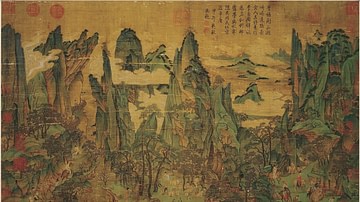Server Costs Fundraiser 2024
Help our mission to provide free history education to the world! Please donate and contribute to covering our server costs in 2024. With your support, millions of people learn about history entirely for free every month.
$3926 / $18000
Video
by UNESCO TV NHK Nippon Hoso Kyokai
published on 27 July 2018
With its five flat peaks, Mount Wutai in China is a sacred Buddhist mountain. The cultural landscape is home to forty-one monasteries and includes the East Main Hall of Foguang Temple, the highest surviving timber building of the Tang dynasty, with life-size clay sculptures. It also features the Ming dynasty Shuxiang Temple with a huge complex of 500 statues representing Buddhist stories woven into three-dimensional pictures of mountains and water. Overall, the buildings on the site catalogue the way in which Buddhist architecture developed and influenced palace building in China for over a millennium. Mount Wutai, literally, 'the five terrace mountain', is the highest in Northern China and is remarkable for its morphology of precipitous slopes with five open treeless peaks. Temples have been built on this site from the 1st century AD to the early 20th century.
Source: UNESCO TV / © NHK Nippon Hoso Kyokai
URL: http://whc.unesco.org/en/list/1279/
License & Copyright
Original video by UNESCO TV NHK Nippon Hoso Kyokai. Embedded by James Blake Wiener, published on 27 July 2018. Please check the original source(s) for copyright information. Please note that content linked from this page may have different licensing terms.
The video and its description text are provided by Youtube. This website claims no authorship of this content; we are republishing it for educational purposes.
Cite This Work
APA Style
Kyokai, U. T. N. N. H. (2018, July 27). Mount Wutai (UNESCO/NHK).
World History Encyclopedia. Retrieved from https://www.worldhistory.org/video/1506/mount-wutai-unesconhk/
Chicago Style
Kyokai, UNESCO TV NHK Nippon Hoso. "Mount Wutai (UNESCO/NHK)."
World History Encyclopedia. Last modified July 27, 2018.
https://www.worldhistory.org/video/1506/mount-wutai-unesconhk/.
MLA Style
Kyokai, UNESCO TV NHK Nippon Hoso. "Mount Wutai (UNESCO/NHK)."
World History Encyclopedia. World History Encyclopedia, 27 Jul 2018. Web. 27 Jul 2024.




